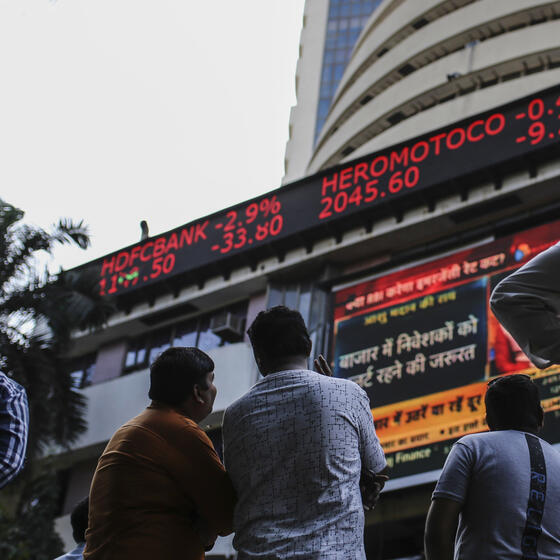Study: Margin Trading Causes Stock Prices to Drop in Concert
During financial crises, stocks tend to fall together more than they should. A new study co-authored by Yale SOM’s Heather Tookes suggests that margin trading plays a substantial role in driving this downward spiral.

Mumbai’s BSE stock exchange on March 9, 2020, as the COVID-19 pandemic sparked a plunge in stock prices. Photo: Dhiraj Singh/Bloomberg via Getty Images.
When a shock hits the market, it’s no surprise that the values of multiple stocks drop simultaneously. For instance, one would expect COVID-19 lockdowns to cause both restaurant and gym company stocks to fall—a phenomenon called comovement. Similarly, stocks tend to rise together during market upswings.
But what has vexed economists is so-called “excess” comovement. This often occurs during financial crises, when the values of many stocks fall in tandem more than one would expect based on fundamental factors, such as bad news about their industries.
In a financial crisis, margin traders can be forced to sell, causing stocks to drop further. “It just spirals,” says Prof. Heather Tookes. “The margin trading system can be an amplification mechanism.”
One possible driver is margin trading, the practice of buying stock with borrowed money. The chain of events might go like this: When stock prices start to fall, investors get skittish and sell, driving prices down further. Values eventually decrease so much that they trigger a margin call, meaning that traders who borrowed money from their brokers must either add more cash to their accounts or sell some of their stocks. When margin traders sell, prices fall again.
“It just spirals,” says Heather Tookes, a professor of finance at Yale SOM. “The margin trading system can be an amplification mechanism.”
While the theory behind this idea was well-established, Tookes and her coauthor, Bige Kahraman at the University of Oxford’s Saïd Business School, wanted to quantify how much margin trading contributed to comovement. They analyzed nine years of data from the stock market in India, where regulations governing margin trading allowed them to get a detailed understanding of the phenomenon.
Margin trading caused more than one-quarter of the increased comovement during market downturns, the researchers estimated. “Everyone knows that comovement goes up during crises,” Tookes says. “This particular channel explains quite a lot of that.”
The study could help policymakers decide whether margin trading should be regulated differently—for instance, if restrictions should change during crises. While margin trading also has benefits, “you have to start thinking about tradeoffs,” Tookes says.
Margin trading works as follows: An investor wants to take a bigger position in a stock than they can pay for, so they borrow from their broker. Typically, the percentage of stock that can be bought with borrowed money is regulated; for example, it might be limited to 50%.
If the stock price rises, the investor can pay off their debt and reap bigger profits than they would have otherwise. But if the price falls significantly, the broker may issue a margin call, forcing the investor to put up more cash or sell.
In India, regulations stipulate that stocks are eligible for margin trading only if they pass two tests. First, the stock must meet a certain threshold for trading frequency. Second, its average impact cost—an estimate of how much the value would change if a trader bought 100,000 rupees’ worth—can’t exceed 1%. Stocks that meet both criteria are called Group 1; stocks that fail the second test are Group 2; and those that meet neither criterion are Group 3.
Tookes and Kahraman studied data on Group 1 and 2 stocks from 2004 to 2012. For each stock, they measured how much the value moved with the market each month.
During financial crises, comovement of both types of stocks increased. But the margin-eligible stocks’ comovement rose by 49%, compared to 37% for ineligible stocks. In contrast, there was no difference in comovement between the two groups during non-crisis periods.
To establish whether margin trading was truly causing the difference, Tookes and Kahraman focused on stocks whose impact costs were just below or just above the 1% threshold—about as close as they could get to a randomized experiment. The same pattern emerged. Margin trading drove 27% of the increased comovement among Group 1 stocks during downturns, the researchers estimated.
To check if this phenomenon was simply due to overall volatility, the team examined periods when the market was performing unusually well. They found no difference between margin-eligible and ineligible stocks.
“Markets are still moving a lot during the rallies,” Tookes says. “The direction just happens to be up versus down. And we don’t see anything.”
The researchers then tried to tease out how margin trading drove stock prices down during crises. One could imagine a couple of scenarios. First, a trader who has borrowed to buy stocks might sell a lot of them all at once. Second, a broker who was facing potential losses might tighten margin requirements or scale back lending.
After examining detailed data on margin trader accounts from 2007 to 2010, the team concluded that brokers were driving much of the increase in comovement. Larger brokers, and those who had a few major clients rather than many small ones, also tended to have bigger effects.
With this study, “we are able to cleanly explain a large part of the comovement pattern that we see during crises,” Tookes says. “And it seems that this supplier of margin lending channel is a main driver.”
The results don’t mean that margin trading is always bad. On average, this practice can help stabilize the market, Tookes says. Margin traders often take contrarian positions; when prices go down by moderate amounts, they tend to buy.
But the results could help policymakers who are considering whether margin trading restrictions should shift depending on market conditions. Future studies of markets in other countries with varying margin requirements “can shed light on what helps and what hurts,” Tookes says.